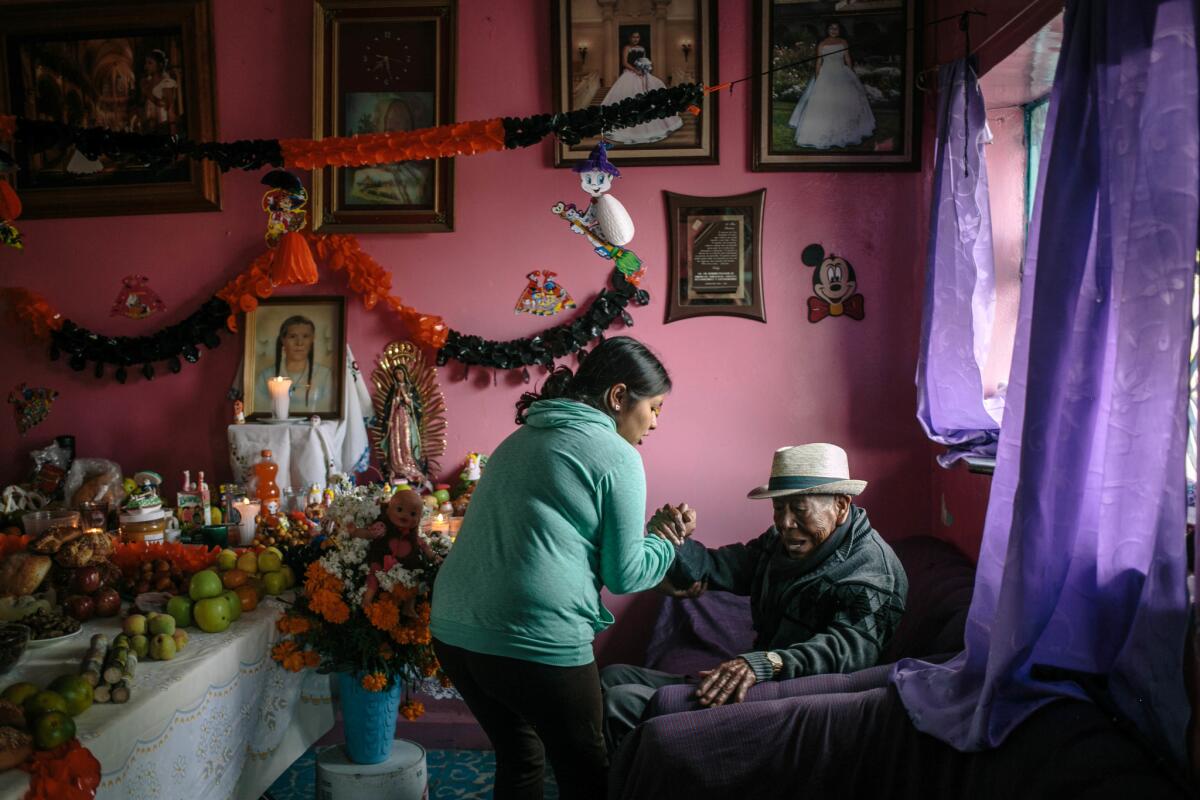How the Día de Muertos tradition continues, even after losing everything in the 7.1 quake in Mexico

The concrete-floor home that Raul Osorio built for his family in this small town was one of his proudest achievements, the fruit of years of laboring in the United States.
It was also the place where the family gathered each fall to honor his wife, Aurea, who died of cancer in 1990. The family would construct an elaborate Day of the Dead altar for Aurea overflowing with fruit, sweet bread and a traditional shock of orange marigolds.
Her soul, according to pre-Hispanic custom, would visit during those sacred days, joining her husband and children for a meal of mole, beans and rice.
The tradition was threatened this year by the magnitude 7.1 earthquake that devastated a large swath of central Mexico last month. With its epicenter less than two dozen miles from Metepec, which is near the city of Puebla, the quake split the walls of the house, damaged the roof and left the staircase on the verge of collapse.
With a spray of red paint near the front door, government workers declared the home uninhabitable, forcing Osorio’s two sons, who lived in the house with their wives and children, to move in with relatives.
Residents of more than 200 other collapsed or badly damaged homes in Metepec were left in the same predicament. More than six weeks after the earthquake, many are homeless and living in makeshift shelters on the street.
Looming over Day of the Dead celebrations that kicked off here this week was a question: How does a community that has lost so much remember the dead?
“Even if we only had one glass of water and a small candle we would make an altar,” said Osorio, 74.
“This is when her soul visits us,” said his son, Areal Osorio, 32. “We have to be here.”
On Oct. 31, the family returned home.
“Look at the water stains,” said the other son, Jalid, 42.
“Yes, it’s nasty,” his father said.
The elder had entered the U.S. illegally seven times before his wife’s death and worked long hours as a waiter and a house painter in New York to pay for the house.
“This was your inheritance,” he said.
Despite the government’s ruling, the family had decided to build an altar under a large wooden crucifix and two framed photographs of Aurea in the living room, which suffered less damage than the dining room, where they usually put it.
A thick layer of dust covered everything — the children’s toys, the old-model desktop computer, the large blue flag celebrating Puebla’s soccer team. One of Osorio’s daughter-in-laws started sweeping up dirt and fallen plaster while the other tacked a white curtain to the wall and then pulled a table beneath it.
“We’re inventing it as we go,” said Angelica Martinez, 35.
The Sept. 19 earthquake killed at least 370 people and injured 6,000 more. People in rural towns such as Metepec complain that they have received less help from government authorities than victims in Mexico City. After the quake, residents here went 12 days without water before taking matters into their own hands, removing hunks of stone that had fallen onto water pipes and shoveling debris out of the streets so cars could pass.
The region, whose rolling hills are lined with greenhouses and fields, is one of the largest producers of flowers in Mexico, sending roses, gladiolas — and marigolds — to the United States, Canada and Europe. Historically, it has also been a top sender of migrants to the U.S.
It is also one of the parts of Mexico where Day of the Dead, which takes place Wednesday and Thursday, is taken most seriously. Tourists come to Puebla and the surrounding towns to photograph magnificent altars spilling out of people’s homes and town squares.
The municipalities in the region have done their best to continue the tradition despite the earthquake’s toll. In nearby Atlixco, where dozens of historic buildings collapsed, city workers laid out a carpet of bright flowers in the center of town. In Metepec, residents made their way to a hillside cemetery to clean the graves of their loved ones.
On a recent cool evening, as birds squawked from leafy trees, Alba Alvarez Martinez and her husband bent over the gravesites of his parents with shovels, preparing the earth for a fresh batch of traditional marigolds.
The couple spent two decades working in Arizona to build a house back in their hometown of Metepec. The structure suffered about $6,000 worth of damage in the earthquake, Alvarez said: “We just feel depressed.”
Still, they never considered not observing Day of the Dead. Even when she lived in the U.S., using a fake Social Security card to work at Pizza Hut, she prepared an altar every year.
“We have to honor our ancestors,” she said. One day, she and her husband would be buried in plots nearby and their family members would honor them in the same way.
She and her husband planned to come with plates of tacos and rice and eat at the cemetery. Others would crack cans of beer for their dead ancestors, or strum songs for them on the guitar.
Back at the Osorio home, the family was getting close to finishing the altar.
They carried in marigolds, whose petals they would scatter in a path from the street all the way to the altar, to help guide Aurea’s soul. Beneath her photo, they stacked traditional pan de muertos. Suddenly, the house smelled sweet. The next day, it would smell like mole, and the family and their matriarch would sit down to eat.
Twitter: @katelinthicum
Sign up for Essential California
The most important California stories and recommendations in your inbox every morning.
You may occasionally receive promotional content from the Los Angeles Times.








